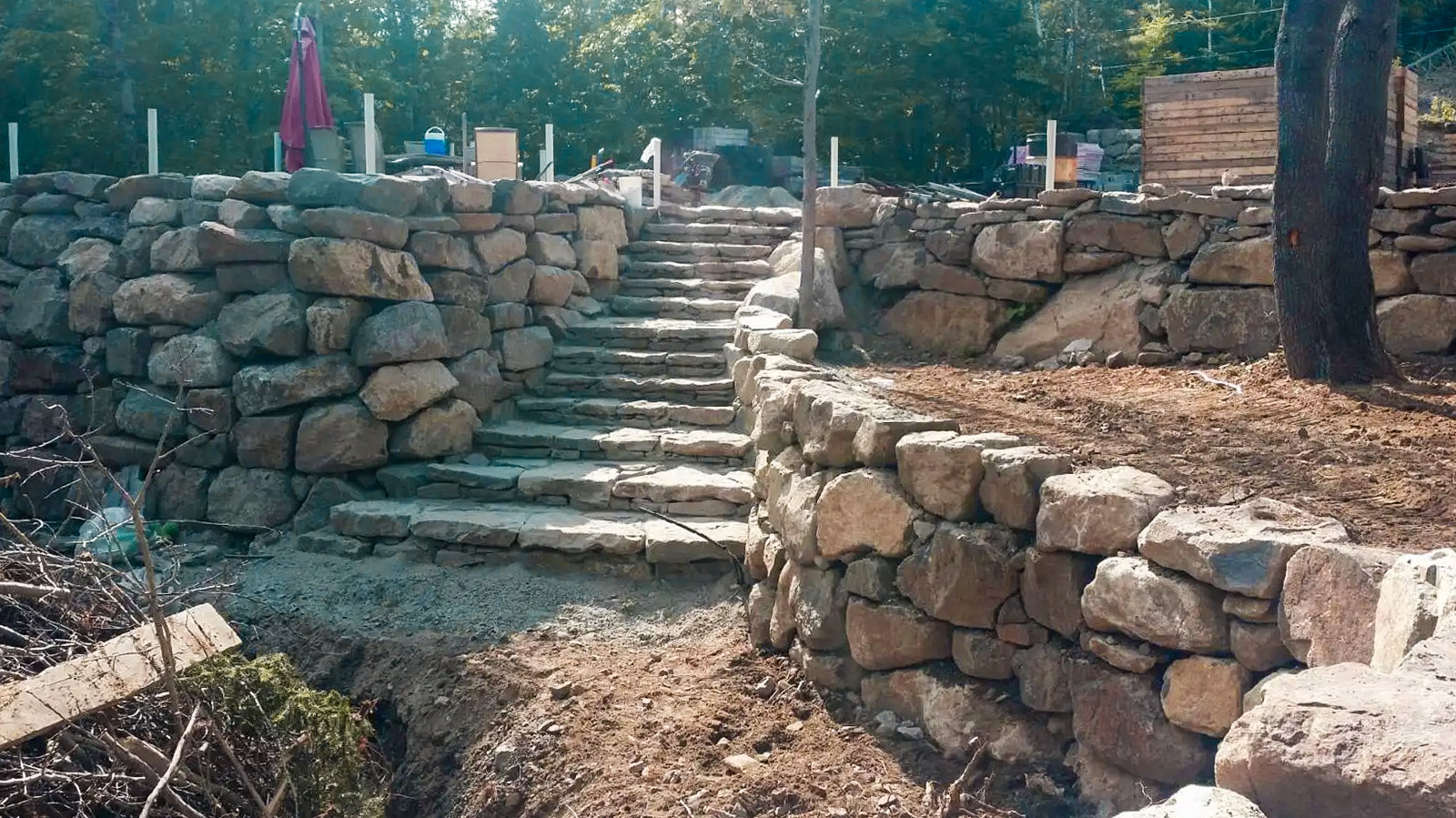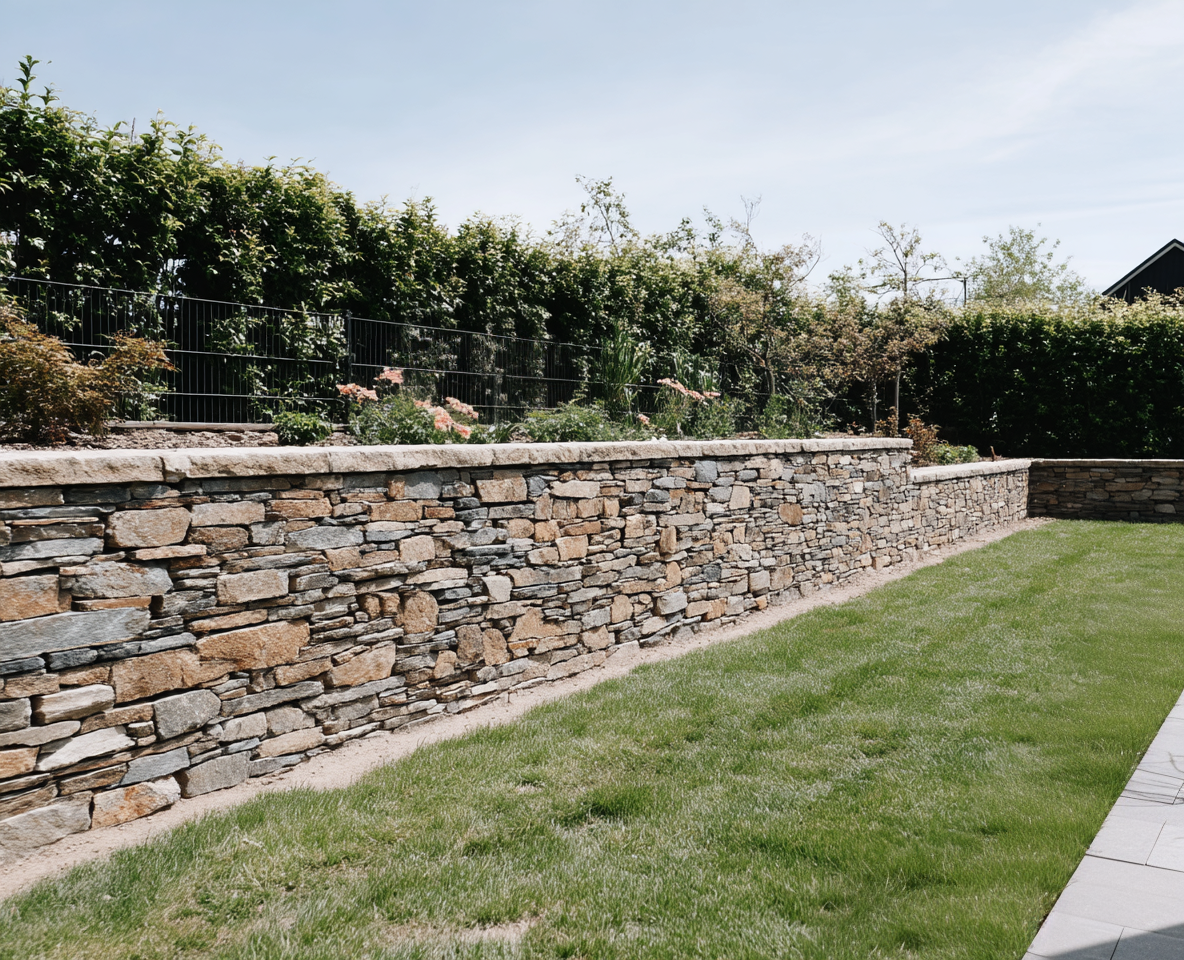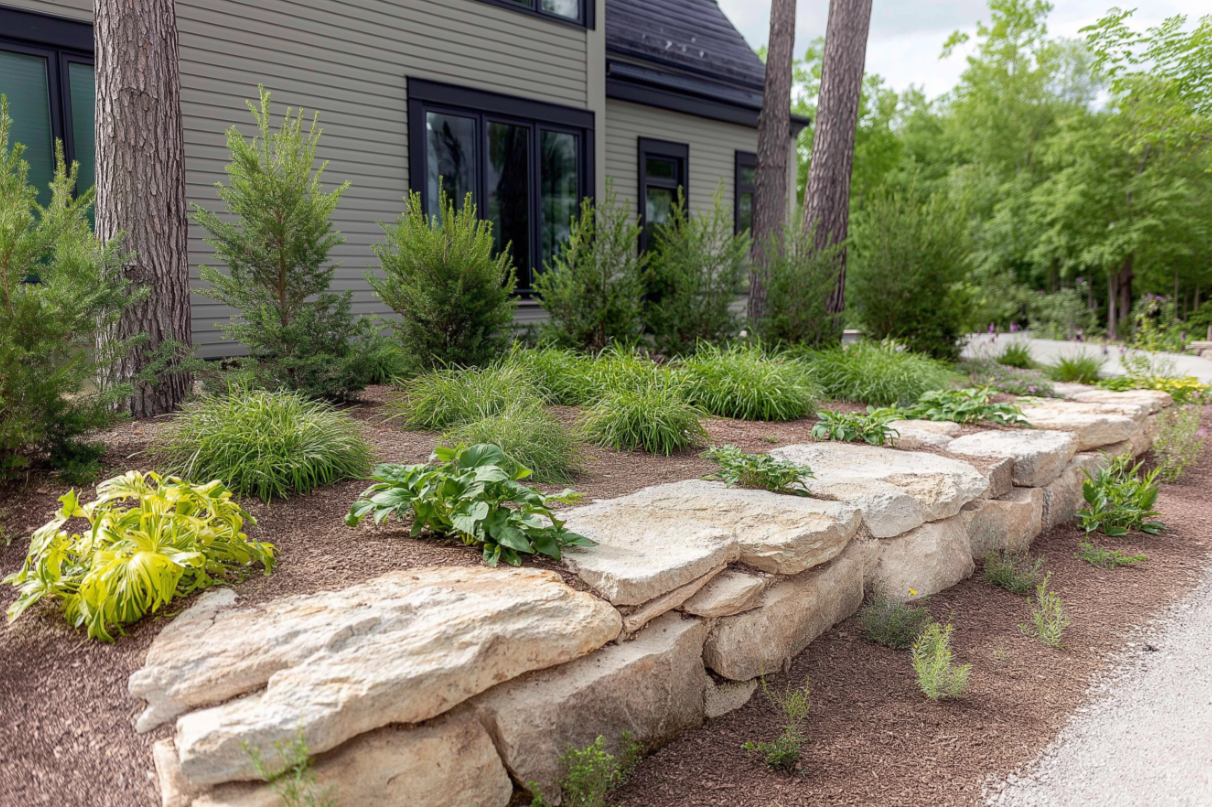
Are you looking to build a retaining wall on your property, but do not really know where to start? RenoQuotes.com has all the information you will need to adequately build a retaining wall.
Building a retaining wall on your property can be quite a tricky endeavour. So, why do you need a retaining wall? A retaining wall is nothing more or less than an exterior wall, commonly found on a slope and used to hold back soil, rubble, etc. This type of wall can also be useful to protect your property from flooding and soil erosion, while simultaneously serving as a noise control barrier and fence.
Basic Steps to Build a Retaining Wall

Source : 9213-6449 Québec Inc.
First off, to determine how many stone blocks you will need for your little endeavour, divide the length of the desired wall by the length of the stones. Repeat to determine the height.
Then, gather the necessary tools:
Safety equipment (goggles, gloves);
Shovel;
Measuring tape;
Hammer/rubber mallet;
Chisel;
Level;
String;
Garden stakes;
Base foundation (sand or other).
Once you have everything you need to complete the project, start preparing the spot on which the wall will be built. To do this, spray paint the ground to outline the area to accurately map out the spot. Also, use strings and garden stakes to define the space in terms of height.
Next, dig up a trench. For a higher retaining wall, you will need to dig and lay the first row completely beneath the ground, while for walls with less than three rows, you can dig down to about half. The trench should be about 12 inches wide and make sure that it is well packed. You can then lay the base (check with your supplier to see what kind of material is best).
Once the base is ready to go, you can move on to laying the first row of stones. Use a level to ensure the row is evenly set. For the next row, follow a slightly staggered pattern, so that the stone in the second row is placed in the middle of where the two bottom stones meet. If necessary, you can cut the stones to fit the pattern. You can do this with a hammer and chisel. Lastly, add soil to complete the wall's finish and to make it structurally sound. In some cases, you can use an adhesive product specially designed for exterior wall stones.
Guidelines to Build a Retaining Wall

Source : RenoQuotes
To build a retaining wall that meets all standards and is structurally sound, there are several factors to consider. First, you must conduct a soil analysis. This analysis will be necessary to determine the loads your soil can withstand to avoid a possible punching shear failure or a landslide.
Assess the state of the soil
Get an expert to assess the condition of your soil and guide you through the work that needs to be done. Then, you really need to pay close attention to your foundations. It will be extremely important to build a footing that will spread loads of your new yard wall evenly.
Choosing the right materials
It is super important to use quality materials for both your foundation and your wall. Should you use low-quality materials to build your wall, you risk encountering significant problems along the way. Then, you will need to put in an efficient drainage system. To prevent the wall from cracking and collapsing under the weight of the water, it is essential to have an efficient drainage system.
You will also need to be sure that the wall is waterproof. Depending on the material you use to build your retaining wall, having a protective coating on the back of the wall, which is in proximity to the soil and water, will be crucial to avoid any problems down the line. Last but not least, do not forget to regularly maintain your retaining wall.
An important feature to check from time to time is the drainage system; ensure it does not clog over time.
Cost of a Retaining Wall

Source : RenoQuotes
Building a retaining wall can vary in price. It largely depends on the materials used and whether you can DIY it or need to hire a qualified contractor to do it for you. However, note that building a retaining wall of this type does require some know-how since it is a major endeavour.
DIY Your Wall or Hire a Contractor?
It is strongly recommended to hire a specialist. On average, if you do the work yourself, the blocks alone can cost you between $20 and $50 per square foot. However, if you hire a specialist to do the work, the cost per square foot can range from $20 to $160, labour included.
To learn about the cost of such a project, feel free to request quotes from contractors who will come to your home and evaluate the work in question.
Recap: Building a Retaining Wall
Measure the width and height of the wall;
Choose the material for the wall and base;
Gather the necessary tools;
Prepare the yard;
Dig and lay the base;
Lay the first row and ensure it is levelled;
Lay the remaining rows;
Finishing touches.
If you want to know how to build a stone wall, check out our article How to Build a Stone Wall in Your Backyard.
Get 3 renovation quotes for your retaining wall project
RenoQuotes.com can help you get quotes for your masonry project. By submitting your project, we’ll put you in contact with top-rated contractors. Fill in the form on the homepage (it only takes a few minutes), and you will get estimates from trusted professionals.
Dial 1-844 828-1588 to speak with one of our customer service representatives.
Looking for something else?
Related articles
The latest industry news, interviews, technologies, and resources.

Léa Plourde-Archer
•26 Aug 2024
Are your hardwood floors damaged? Thinking of renovating them? RenoQuotes.com has got you covered, detailing solutions for repairing hardwood floors, including various ways to refinish your wood floors for effectively shielding newly buffed surfaces.

Cynthia Pigeon
•07 Nov 2023
While thermal insulation is a top priority for most homeowners, proper roof ventilation is also critical to keeping your roofing system in tip-top shape. A roof vent cap is key to achieving this goal.

Editorial Team
•16 Jun 2025
It goes without saying that no one likes to feel cold inside their home, especially when winter knocks on our doors. As insulation in the attic is critical to the preservation of a comfortable indoor temperature, it is important to understand which materials and techniques need to be used to ensure that it is optimal.

Léa Plourde-Archer
•17 Apr 2024
In today’s climate, plenty of homeowners are looking for ways to directly deal with their carbon footprint and the lasting effects on the environment.

Editorial Team
•20 Dec 2023
When the months start to feel warmer, there’s nothing we crave more than some time outside. There are plenty of ways to make the most of your front or backyard, and this includes building a beautiful deck. If you’ve been considering this project but are having a hard time making a concrete choice between the different materials on the market, then look no further!